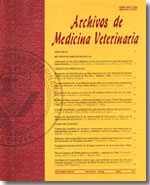Viability assessment of cachama blanca (Piaractus brachypomus) embryos preserved at -14 °C and obtained at different stages of the embryonic development
Main Article Content
Abstract
The aim of this study was to assess the viability of embryo preservation from different hour post-fertilization (1, 6 and 7 HPF) for 1 hour at -14 °C. Different cryoprotectants (Ethylene glycol, ETG and methanol, MET) and concentrations (10% and 15%) were used. Sexually matured animals (male and female) were hormonally induced, and once the latency time was over, spawning was performed to obtain the gametes and conduct the egg fertilization. The eggs were finally placed in a 200 L upflow cylindro-conoidal incubator. The stage of the embryonic development, when the embryos were subjected to -14 C° for each post-fertilization hour (HPF), was ~8 to 16 cells for the 1HPF, (50% of epiboly) gastrulation for the 6HPF, and segmentation (formation of 13 somites and the appearing of the optic vesicle) for 10 HPF embryos. Once each HPF was over, both the feasible embryos and the diluent were packed in 13 mL Falcon tubes (1:1), and placed for 10 minutes in a box at 6.2 °C, to be preserved at -14 °C for 60 minutes. Non-preserved embryos were treated as control. The embryos were defrosted and placed in an incubator to start the artificial incubation process again. The highest hatching rate was seen in 10 HPF embryos preserved with 10% and 15% MET (87.0±1.8% and 83.3±3.1%, respectively). No major statistical differences were shown regarding the control (90.6±1.1%) (P < 0.05). Ten HPF Piaractus brachypomus embryos stored at -14 °C for 1 hour using MET at 10% and 15% as cryoprotectants preserved their feasibility, obtaining satisfactory hatching percentages.

